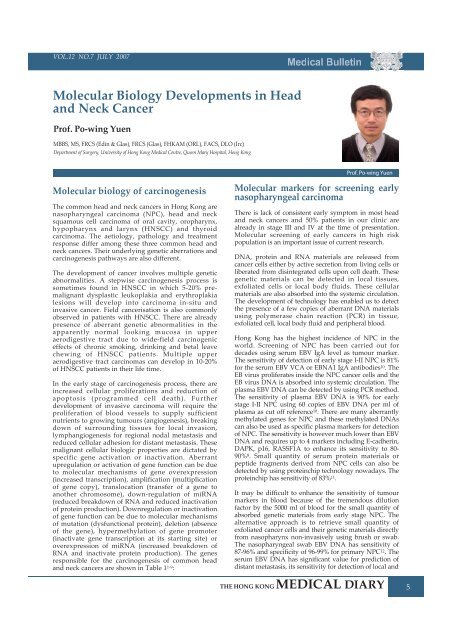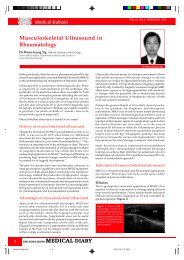MEDICAL DIARY - The Federation of Medical Societies of Hong Kong
MEDICAL DIARY - The Federation of Medical Societies of Hong Kong
MEDICAL DIARY - The Federation of Medical Societies of Hong Kong
You also want an ePaper? Increase the reach of your titles
YUMPU automatically turns print PDFs into web optimized ePapers that Google loves.
VOL.11 VOL.12NO.5 NO.7 MAY JULY 20062007<br />
Molecular Biology Developments in Head<br />
and Neck Cancer<br />
Pr<strong>of</strong>. Po-wing Yuen<br />
MBBS, MS, FRCS (Edin & Glas), FRCS (Glas), FHKAM (ORL), FACS, DLO (Irc)<br />
Department <strong>of</strong> Surgery, University <strong>of</strong> <strong>Hong</strong> <strong>Kong</strong> <strong>Medical</strong> Centre, Queen Mary Hospital, <strong>Hong</strong> <strong>Kong</strong><br />
Molecular biology <strong>of</strong> carcinogenesis<br />
<strong>The</strong> common head and neck cancers in <strong>Hong</strong> <strong>Kong</strong> are<br />
nasopharyngeal carcinoma (NPC), head and neck<br />
squamous cell carcinoma <strong>of</strong> oral cavity, oropharynx,<br />
hypopharynx and larynx (HNSCC) and thyroid<br />
carcinoma. <strong>The</strong> aetiology, pathology and treatment<br />
response differ among these three common head and<br />
neck cancers. <strong>The</strong>ir underlying genetic aberrations and<br />
carcinogenesis pathways are also different.<br />
<strong>The</strong> development <strong>of</strong> cancer involves multiple genetic<br />
abnormalities. A stepwise carcinogenesis process is<br />
sometimes found in HNSCC in which 5-20% premalignant<br />
dysplastic leukoplakia and erythroplakia<br />
lesions will develop into carcinoma in-situ and<br />
invasive cancer. Field cancerisation is also commonly<br />
observed in patients with HNSCC. <strong>The</strong>re are already<br />
presence <strong>of</strong> aberrant genetic abnormalities in the<br />
apparently normal looking mucosa in upper<br />
aerodigestive tract due to wide-field carcinogenic<br />
effects <strong>of</strong> chronic smoking, drinking and betal leave<br />
chewing <strong>of</strong> HNSCC patients. Multiple upper<br />
aerodigestive tract carcinomas can develop in 10-20%<br />
<strong>of</strong> HNSCC patients in their life time.<br />
In the early stage <strong>of</strong> carcinogenesis process, there are<br />
increased cellular proliferations and reduction <strong>of</strong><br />
apoptosis (programmed cell death). Further<br />
development <strong>of</strong> invasive carcinoma will require the<br />
proliferation <strong>of</strong> blood vessels to supply sufficient<br />
nutrients to growing tumours (angiogenesis), breaking<br />
down <strong>of</strong> surrounding tissues for local invasion,<br />
lymphangiogenesis for regional nodal metastasis and<br />
reduced cellular adhesion for distant metastasis. <strong>The</strong>se<br />
malignant cellular biologic properties are dictated by<br />
specific gene activation or inactivation. Aberrant<br />
upregulation or activation <strong>of</strong> gene function can be due<br />
to molecular mechanisms <strong>of</strong> gene overexpression<br />
(increased transcription), amplification (multiplication<br />
<strong>of</strong> gene copy), translocation (transfer <strong>of</strong> a gene to<br />
another chromosome), down-regulation <strong>of</strong> miRNA<br />
(reduced breakdown <strong>of</strong> RNA and reduced inactivation<br />
<strong>of</strong> protein production). Downregulation or inactivation<br />
<strong>of</strong> gene function can be due to molecular mechanisms<br />
<strong>of</strong> mutation (dysfunctional protein), deletion (absence<br />
<strong>of</strong> the gene), hypermethylation <strong>of</strong> gene promoter<br />
(inactivate gene transcription at its starting site) or<br />
overexpression <strong>of</strong> miRNA (increased breakdown <strong>of</strong><br />
RNA and inactivate protein production). <strong>The</strong> genes<br />
responsible for the carcinogenesis <strong>of</strong> common head<br />
and neck cancers are shown in Table 1 1-9:<br />
<strong>Medical</strong> Bulletin<br />
Pr<strong>of</strong>. Po-wing Yuen<br />
Molecular markers for screening early<br />
nasopharyngeal carcinoma<br />
<strong>The</strong>re is lack <strong>of</strong> consistent early symptom in most head<br />
and neck cancers and 50% patients in our clinic are<br />
already in stage III and IV at the time <strong>of</strong> presentation.<br />
Molecular screening <strong>of</strong> early cancers in high risk<br />
population is an important issue <strong>of</strong> current research.<br />
DNA, protein and RNA materials are released from<br />
cancer cells either by active secretion from living cells or<br />
liberated from disintegrated cells upon cell death. <strong>The</strong>se<br />
genetic materials can be detected in local tissues,<br />
exfoliated cells or local body fluids. <strong>The</strong>se cellular<br />
materials are also absorbed into the systemic circulation.<br />
<strong>The</strong> development <strong>of</strong> technology has enabled us to detect<br />
the presence <strong>of</strong> a few copies <strong>of</strong> aberrant DNA materials<br />
using polymerase chain reaction (PCR) in tissue,<br />
exfoliated cell, local body fluid and peripheral blood.<br />
<strong>Hong</strong> <strong>Kong</strong> has the highest incidence <strong>of</strong> NPC in the<br />
world. Screening <strong>of</strong> NPC has been carried out for<br />
decades using serum EBV IgA level as tumour marker.<br />
<strong>The</strong> sensitivity <strong>of</strong> detection <strong>of</strong> early stage I-II NPC is 81%<br />
for the serum EBV VCA or EBNA1 IgA antibodies 10. <strong>The</strong><br />
EB virus proliferates inside the NPC cancer cells and the<br />
EB virus DNA is absorbed into systemic circulation. <strong>The</strong><br />
plasma EBV DNA can be detected by using PCR method.<br />
<strong>The</strong> sensitivity <strong>of</strong> plasma EBV DNA is 90% for early<br />
stage I-II NPC using 60 copies <strong>of</strong> EBV DNA per ml <strong>of</strong><br />
plasma as cut <strong>of</strong>f reference 10. <strong>The</strong>re are many aberrantly<br />
methylated genes for NPC and these methylated DNAs<br />
can also be used as specific plasma markers for detection<br />
<strong>of</strong> NPC. <strong>The</strong> sensitivity is however much lower than EBV<br />
DNA and requires up to 4 markers including E-cadherin,<br />
DAPK, p16, RASSF1A to enhance its sensitivity to 80-<br />
90% 8. Small quantity <strong>of</strong> serum protein materials or<br />
peptide fragments derived from NPC cells can also be<br />
detected by using proteinchip technology nowadays. <strong>The</strong><br />
proteinchip has sensitivity <strong>of</strong> 83% 11.<br />
It may be difficult to enhance the sensitivity <strong>of</strong> tumour<br />
markers in blood because <strong>of</strong> the tremendous dilution<br />
factor by the 5000 ml <strong>of</strong> blood for the small quantity <strong>of</strong><br />
absorbed genetic materials from early stage NPC. <strong>The</strong><br />
alternative approach is to retrieve small quantity <strong>of</strong><br />
exfoliated cancer cells and their genetic materials directly<br />
from nasopharynx non-invasively using brush or swab.<br />
<strong>The</strong> nasopharyngeal swab EBV DNA has sensitivity <strong>of</strong><br />
87-96% and specificity <strong>of</strong> 96-99% for primary NPC 12. <strong>The</strong><br />
serum EBV DNA has significant value for prediction <strong>of</strong><br />
distant metastasis, its sensitivity for detection <strong>of</strong> local and<br />
5
















